traction control SKODA SUPERB 2004 1.G / (B5/3U) Owner's Manual
[x] Cancel search | Manufacturer: SKODA, Model Year: 2004, Model line: SUPERB, Model: SKODA SUPERB 2004 1.G / (B5/3U)Pages: 270
Page 30 of 270
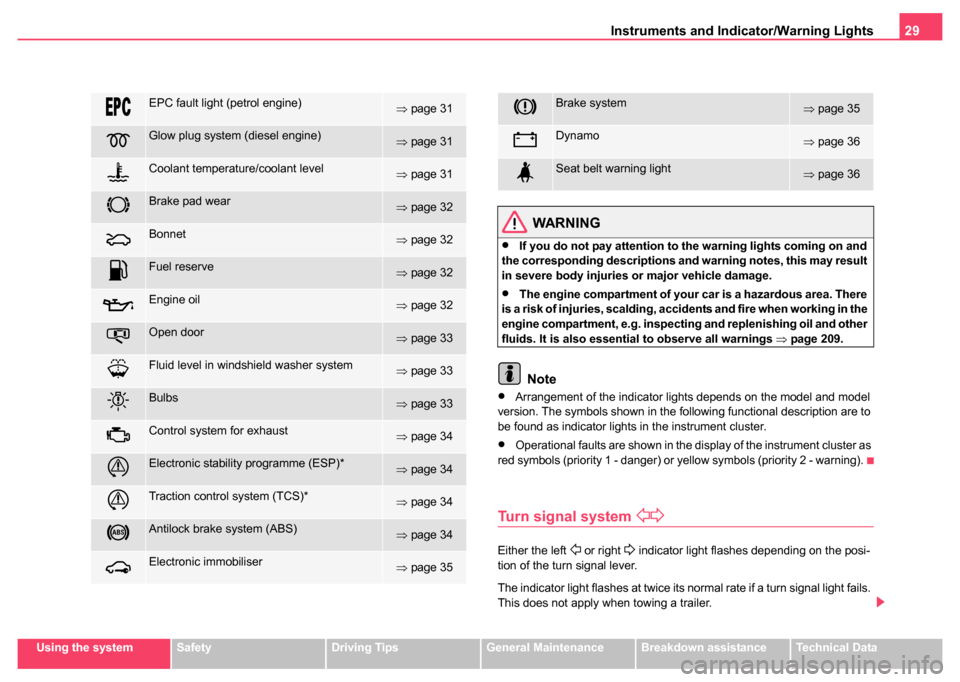
Instruments and Indicator/Warning Lights29
Using the systemSafetyDriving TipsGeneral MaintenanceBreakdown assistanceTechnical Data
WARNING
•If you do not pay attention to the warning lights coming on and
the corresponding descriptions and warning notes, this may result
in severe body injuries or major vehicle damage.
•The engine compartment of your car is a hazardous area. There
is a risk of injuries, scalding, acci dents and fire when working in the
engine compartment, e.g. inspec ting and replenishing oil and other
fluids. It is also essential to observe all warnings ⇒page 209.
Note
•Arrangement of the indicator lights depends on the model and model
version. The symbols shown in the following functional description are to
be found as indicator lights in the instrument cluster.
•Operational faults are shown in the display of the instrument cluster as
red symbols (priority 1 - danger) or yellow symbols (priority 2 - warning).
Turn signal system
Either the left or right indicator light flashes depending on the posi-
tion of the turn signal lever.
The indicator light flashes at twice its normal rate if a turn signal light fails.
This does not apply when towing a trailer.
EPC fault light (petrol engine)⇒ page 31
Glow plug system (diesel engine)⇒page 31
Coolant temperature/coolant level⇒page 31
Brake pad wear⇒page 32
Bonnet⇒page 32
Fuel reserve⇒page 32
Engine oil⇒page 32
Open door⇒page 33
Fluid level in windshield washer system⇒page 33
Bulbs⇒page 33
Control system for exhaust⇒page 34
Electronic stability programme (ESP)*⇒page 34
Traction control system (TCS)*⇒page 34
Antilock brake system (ABS)⇒page 34
Electronic immobiliser⇒page 35
Brake system⇒page 35
Dynamo⇒page 36
Seat belt warning light⇒page 36
Page 35 of 270
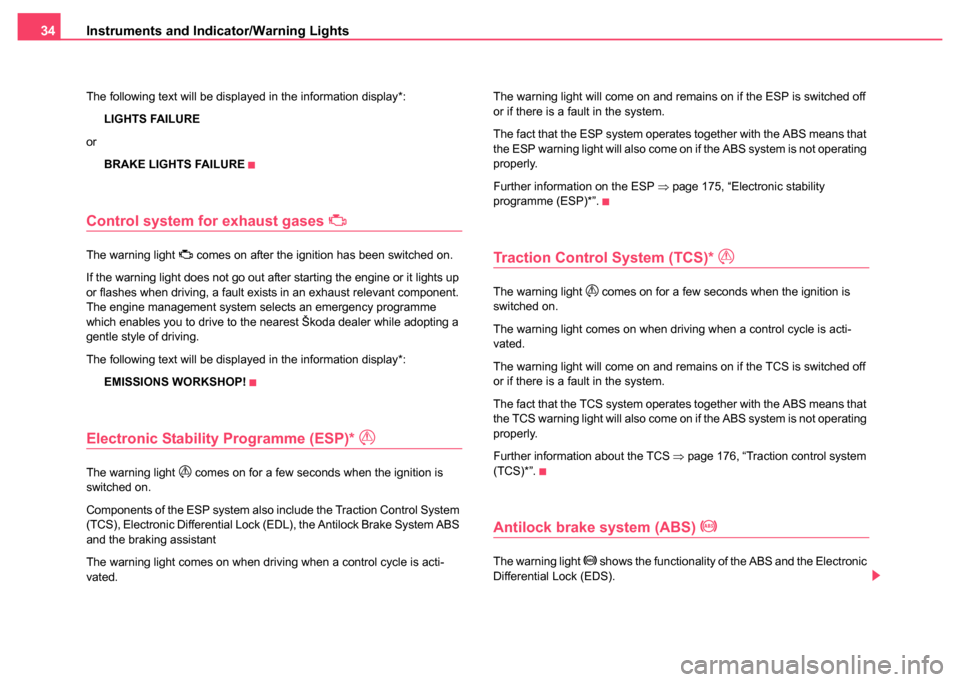
Instruments and Indicator/Warning Lights
34
The following text will be displayed in the information display*:
LIGHTS FAILURE
or BRAKE LIGHTS FAILURE
Control system for exhaust gases
The warning light comes on after the ignition has been switched on.
If the warning light does not go out after starting the engine or it lights up
or flashes when driving, a fault exists in an exhaust relevant component.
The engine management system selects an emergency programme
which enables you to drive to the nearest Škoda dealer while adopting a
gentle style of driving.
The following text will be displayed in the information display*: EMISSIONS WORKSHOP!
Electronic Stability Programme (ESP)*
The warning light comes on for a few seconds when the ignition is
switched on.
Components of the ESP system also include the Traction Control System
(TCS), Electronic Differential Lock (EDL), the Antilock Brake System ABS
and the braking assistant
The warning light comes on when driving when a control cycle is acti-
vated. The warning light will come on and remains on if the ESP is switched off
or if there is a fault in the system.
The fact that the ESP system operates together with the ABS means that
the ESP warning light will also come on if the ABS system is not operating
properly.
Further information on the ESP
⇒page 175, “Electronic stability
programme (ESP)*”.
Traction Control System (TCS)*
The warning light comes on for a few seconds when the ignition is
switched on.
The warning light comes on when driving when a control cycle is acti-
vated.
The warning light will come on and remains on if the TCS is switched off
or if there is a fault in the system.
The fact that the TCS system operates together with the ABS means that
the TCS warning light will also come on if the ABS system is not operating
properly.
Further information about the TCS ⇒page 176, “Traction control system
(TCS)*”.
Antilock brake system (ABS)
The warning light shows the functionality of the ABS and the Electronic
Differential Lock (EDS).
Page 176 of 270
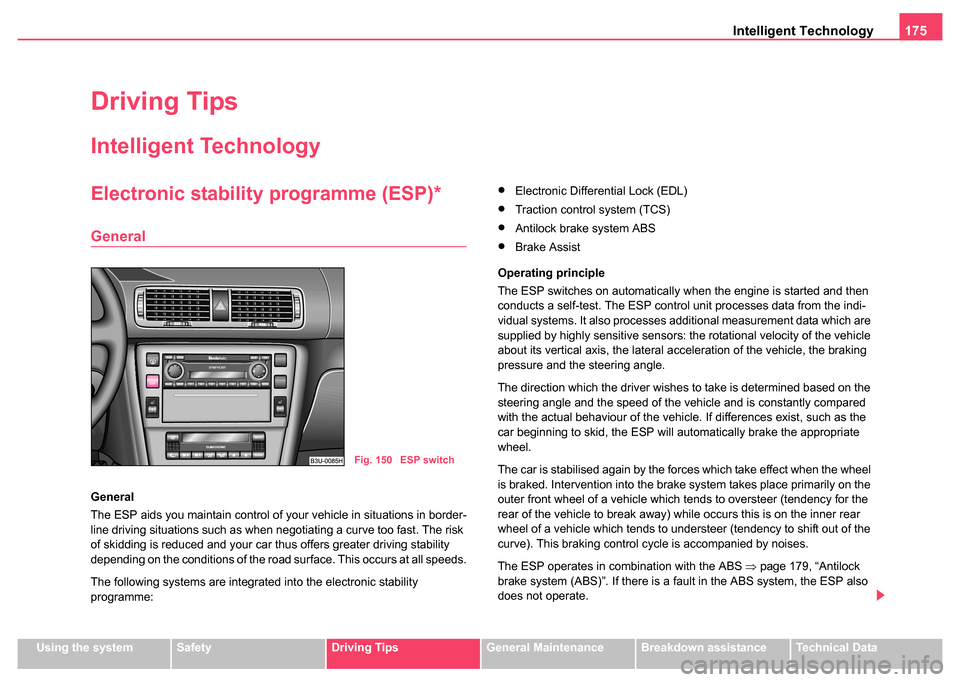
Intelligent Technology175
Using the systemSafetyDriving TipsGeneral MaintenanceBreakdown assistanceTechnical Data
Driving Tips
Intelligent Technology
Electronic stability programme (ESP)*
General
General
The ESP aids you maintain control of your vehicle in situations in border-
line driving situations such as when negotiating a curve too fast. The risk
of skidding is reduced and your car thus offers greater driving stability
depending on the conditions of the road surface. This occurs at all speeds.
The following systems are integrated into the electronic stability
programme:
•Electronic Differential Lock (EDL)
•Traction control system (TCS)
•Antilock brake system ABS
•Brake Assist
Operating principle
The ESP switches on automatically when the engine is started and then
conducts a self-test. The ESP control unit processes data from the indi-
vidual systems. It also processes additional measurement data which are
supplied by highly sensitive sensors: the rotational velocity of the vehicle
about its vertical axis, the lateral acceleration of the vehicle, the braking
pressure and the steering angle.
The direction which the driver wishes to take is determined based on the
steering angle and the speed of the vehicle and is constantly compared
with the actual behaviour of the vehicle. If differences exist, such as the
car beginning to skid, the ESP will automatically brake the appropriate
wheel.
The car is stabilised again by the forces which take effect when the wheel
is braked. Intervention into the brake system takes place primarily on the
outer front wheel of a vehicle which tends to oversteer (tendency for the
rear of the vehicle to break away) while occurs this is on the inner rear
wheel of a vehicle which tends to understeer (tendency to shift out of the
curve). This braking control cycle is accompanied by noises.
The ESP operates in combination with the ABS ⇒page 179, “Antilock
brake system (ABS)”. If there is a fault in the ABS system, the ESP also
does not operate.
Fig. 150 ESP switch
Page 177 of 270
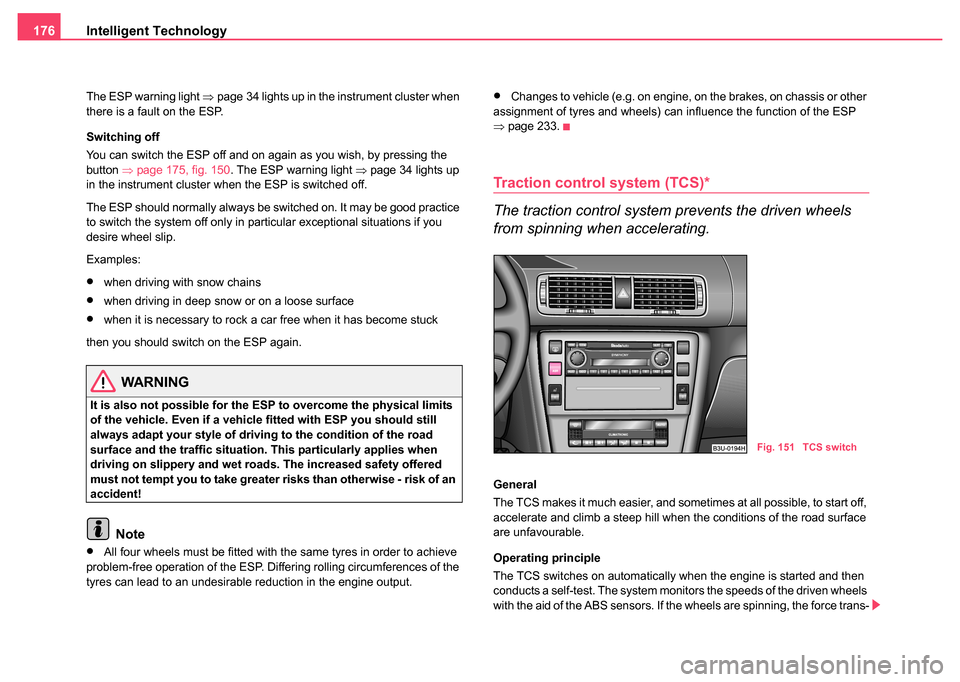
Intelligent Technology
176
The ESP warning light ⇒page 34 lights up in the instrument cluster when
there is a fault on the ESP.
Switching off
You can switch the ESP off and on again as you wish, by pressing the
button ⇒page 175, fig. 150 . The ESP warning light ⇒ page 34 lights up
in the instrument cluster when the ESP is switched off.
The ESP should normally always be switched on. It may be good practice
to switch the system off only in particular exceptional situations if you
desire wheel slip.
Examples:
•when driving with snow chains
•when driving in deep snow or on a loose surface
•when it is necessary to rock a car free when it has become stuck
then you should switch on the ESP again.
WARNING
It is also not possible for the E SP to overcome the physical limits
of the vehicle. Even if a vehicle fitted with ESP you should still
always adapt your style of driving to the condition of the road
surface and the traffic situation. This particularly applies when
driving on slippery and wet roads. The increased safety offered
must not tempt you to take greater risks than otherwise - risk of an
accident!
Note
•All four wheels must be fitted with the same tyres in order to achieve
problem-free operation of the ESP. Differing rolling circumferences of the
tyres can lead to an undesirable reduction in the engine output.
•Changes to vehicle (e.g. on engine, on the brakes, on chassis or other
assignment of tyres and wheels) can influence the function of the ESP
⇒ page 233.
Traction control system (TCS)*
The traction control system prevents the driven wheels
from spinning when accelerating.
General
The TCS makes it much easier, and sometimes at all possible, to start off,
accelerate and climb a steep hill when the conditions of the road surface
are unfavourable.
Operating principle
The TCS switches on automatically when the engine is started and then
conducts a self-test. The system monitors the speeds of the driven wheels
with the aid of the ABS sensors. If the wheels are spinning, the force trans-
Fig. 151 TCS switch
Page 232 of 270
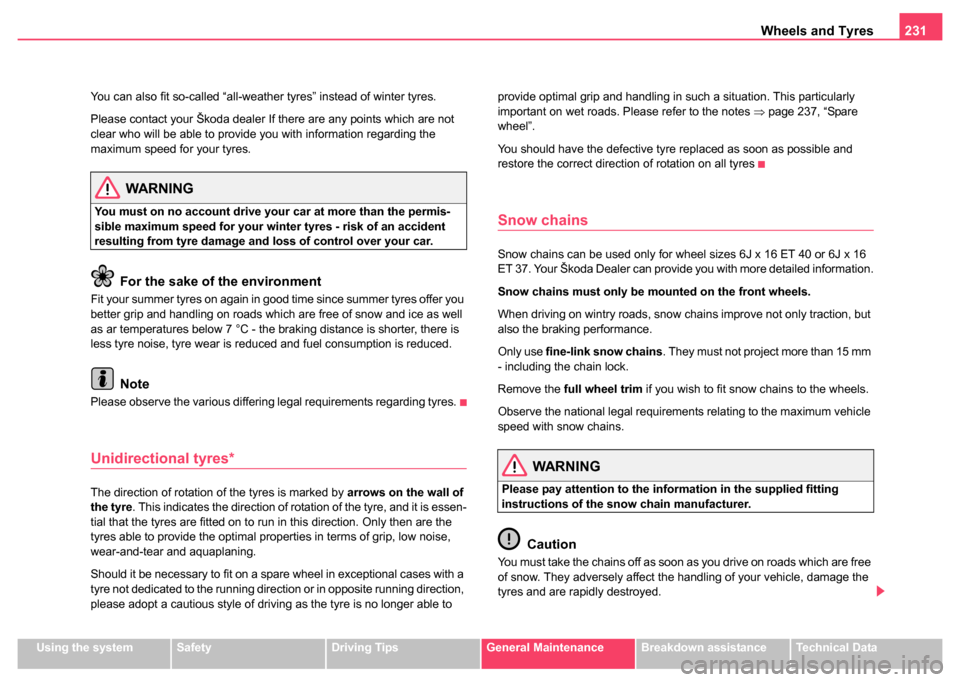
Wheels and Tyres231
Using the systemSafetyDriving TipsGeneral MaintenanceBreakdown assistanceTechnical Data
You can also fit so-called “all-weather tyres” instead of winter tyres.
Please contact your Škoda dealer If there are any points which are not
clear who will be able to provide you with information regarding the
maximum speed fo
r your tyres.
WARNING
You must on no account drive your car at more than the permis-
sible maximum speed for your winter tyres - risk of an accident
resulting from tyre damage and loss of control over your car.
For the sake of the environment
Fit your summer tyres on again in good time since summer tyres offer you
better grip and handling on roads which are free of snow and ice as well
as ar temperatures below 7 °C - the braking distance is shorter, there is
less tyre noise, tyre wear is reduced and fuel consumption is reduced.
Note
Please observe the various differing legal requirements regarding tyres.
Unidirectional tyres*
The direction of rotation of the tyres is marked by arrows on the wall of
the tyre . This indicates the direction of rotation of the tyre, and it is essen-
tial that the tyres are fitted on to run in this direction. Only then are the
tyres able to provide the optimal properties in terms of grip, low noise,
wear-and-tear and aquaplaning.
Should it be necessary to fit on a spare wheel in exceptional cases with a
tyre not dedicated to the running direction or in opposite running direction,
please adopt a cautious style of driving as the tyre is no longer able to provide optimal grip and handling in such a situation. This particularly
important on wet roads. Please refer to the notes
⇒page 237, “Spare
wheel”.
You should have the defective tyre replaced as soon as possible and
restore the correct direction of rotation on all tyres
Snow chains
Snow chains can be used only for wheel sizes 6J x 16 ET 40 or 6J x 16
ET 37. Your Škoda Dealer can provide you with more detailed information.
Snow chains must only be mounted on the front wheels.
When driving on wintry roads, snow chains improve not only traction, but
also the braking performance.
Only use fine-link snow chains . They must not project more than 15 mm
- including the chain lock.
Remove the full wheel trim if you wish to fit snow chains to the wheels.
Observe the national legal requirements relating to the maximum vehicle
speed with snow chains.
WARNING
Please pay attention to the information in the supplied fitting
instructions of the snow chain manufacturer.
Caution
You must take the chains off as soon as you drive on roads which are free
of snow. They adversely affect the handling of your vehicle, damage the
tyres and are rapidly destroyed.
Page 267 of 270
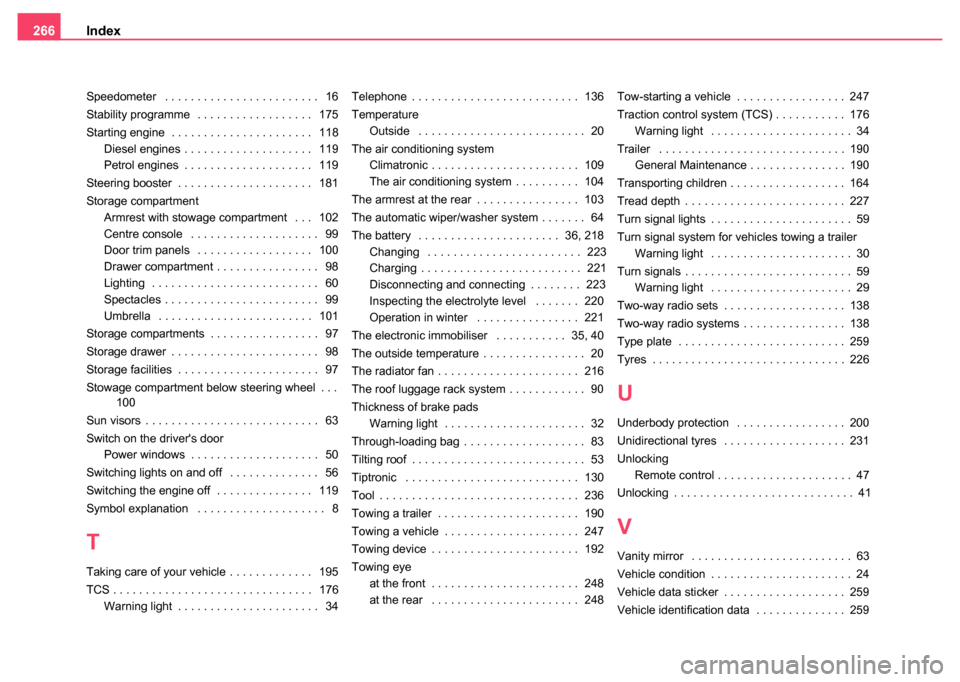
Index
266
Speedometer . . . . . . . . . . . . . . . . . . . . . . . . 16
Stability programme . . . . . . . . . . . . . . . . . . 175
Starting engine . . . . . . . . . . . . . . . . . . . . . . 118
Diesel engines . . . . . . . . . . . . . . . . . . . . 119
Petrol engines . . . . . . . . . . . . . . . . . . . . 119
Steering booster . . . . . . . . . . . . . . . . . . . . . 181
Storage compartment Armrest with stowage compartment . . . 102
Centre console . . . . . . . . . . . . . . . . . . . . 99
Door trim panels . . . . . . . . . . . . . . . . . . 100
Drawer compartment . . . . . . . . . . . . . . . . 98
Lighting . . . . . . . . . . . . . . . . . . . . . . . . . . 60
Spectacles . . . . . . . . . . . . . . . . . . . . . . . . 99
Umbrella . . . . . . . . . . . . . . . . . . . . . . . . 101
Storage compartments . . . . . . . . . . . . . . . . . 97
Storage drawer . . . . . . . . . . . . . . . . . . . . . . . 98
Storage facilities . . . . . . . . . . . . . . . . . . . . . . 97
Stowage compartment below steering wheel . . . 100
Sun visors . . . . . . . . . . . . . . . . . . . . . . . . . . . 63
Switch on the driver's door Power windows . . . . . . . . . . . . . . . . . . . . 50
Switching lights on and off . . . . . . . . . . . . . . 56
Switching the engine off . . . . . . . . . . . . . . . 119
Symbol explanation . . . . . . . . . . . . . . . . . . . . 8
T
Taking care of your vehicle . . . . . . . . . . . . . 195
TCS . . . . . . . . . . . . . . . . . . . . . . . . . . . . . . . 176 Warning light . . . . . . . . . . . . . . . . . . . . . . 34 Telephone . . . . . . . . . . . . . . . . . . . . . . . . . . 136
Temperature
Outside . . . . . . . . . . . . . . . . . . . . . . . . . . 20
The air conditioning system Climatronic . . . . . . . . . . . . . . . . . . . . . . . 109
The air conditioning system . . . . . . . . . . 104
The armrest at the rear . . . . . . . . . . . . . . . . 103
The automatic wiper/washer system . . . . . . . 64
The battery . . . . . . . . . . . . . . . . . . . . . . 36, 218 Changing . . . . . . . . . . . . . . . . . . . . . . . . 223
Charging . . . . . . . . . . . . . . . . . . . . . . . . . 221
Disconnecting and connecting . . . . . . . . 223
Inspecting the electrolyte level . . . . . . . 220
Operation in winter . . . . . . . . . . . . . . . . 221
The electronic immobiliser . . . . . . . . . . . 35, 40
The outside temperature . . . . . . . . . . . . . . . . 20
The radiator fan . . . . . . . . . . . . . . . . . . . . . . 216
The roof luggage rack system . . . . . . . . . . . . 90
Thickness of brake pads Warning light . . . . . . . . . . . . . . . . . . . . . . 32
Through-loading bag . . . . . . . . . . . . . . . . . . . 83
Tilting roof . . . . . . . . . . . . . . . . . . . . . . . . . . . 53
Tiptronic . . . . . . . . . . . . . . . . . . . . . . . . . . . 130
Tool . . . . . . . . . . . . . . . . . . . . . . . . . . . . . . . 236
Towing a trailer . . . . . . . . . . . . . . . . . . . . . . 190
Towing a vehicle . . . . . . . . . . . . . . . . . . . . . 247
Towing device . . . . . . . . . . . . . . . . . . . . . . . 192
Towing eye at the front . . . . . . . . . . . . . . . . . . . . . . . 248
at the rear . . . . . . . . . . . . . . . . . . . . . . . 248 Tow-starting a vehicle . . . . . . . . . . . . . . . . . 247
Traction control system (TCS) . . . . . . . . . . . 176
Warning light . . . . . . . . . . . . . . . . . . . . . . 34
Trailer . . . . . . . . . . . . . . . . . . . . . . . . . . . . . 190 General Maintenance . . . . . . . . . . . . . . . 190
Transporting children . . . . . . . . . . . . . . . . . . 164
Tread depth . . . . . . . . . . . . . . . . . . . . . . . . . 227
Turn signal lights . . . . . . . . . . . . . . . . . . . . . . 59
Turn signal system for vehicles towing a trailer Warning light . . . . . . . . . . . . . . . . . . . . . . 30
Turn signals . . . . . . . . . . . . . . . . . . . . . . . . . . 59 Warning light . . . . . . . . . . . . . . . . . . . . . . 29
Two-way radio sets . . . . . . . . . . . . . . . . . . . 138
Two-way radio systems . . . . . . . . . . . . . . . . 138
Type plate . . . . . . . . . . . . . . . . . . . . . . . . . . 259
Tyres . . . . . . . . . . . . . . . . . . . . . . . . . . . . . . 226
U
Underbody protection . . . . . . . . . . . . . . . . . 200
Unidirectional tyres . . . . . . . . . . . . . . . . . . . 231
Unlocking Remote control . . . . . . . . . . . . . . . . . . . . . 47
Unlocking . . . . . . . . . . . . . . . . . . . . . . . . . . . . 41
V
Vanity mirror . . . . . . . . . . . . . . . . . . . . . . . . . 63
Vehicle condition . . . . . . . . . . . . . . . . . . . . . . 24
Vehicle data sticker . . . . . . . . . . . . . . . . . . . 259
Vehicle identification data . . . . . . . . . . . . . . 259